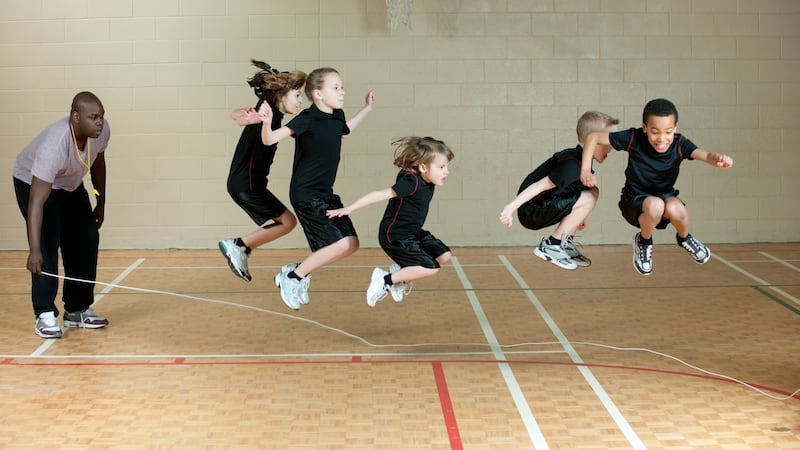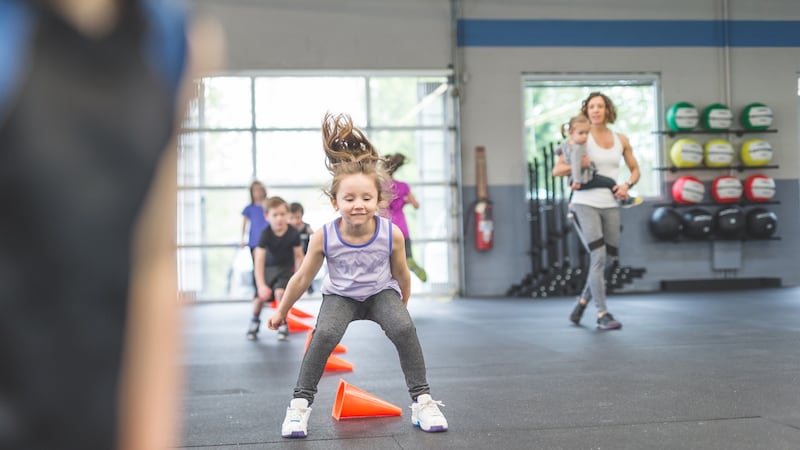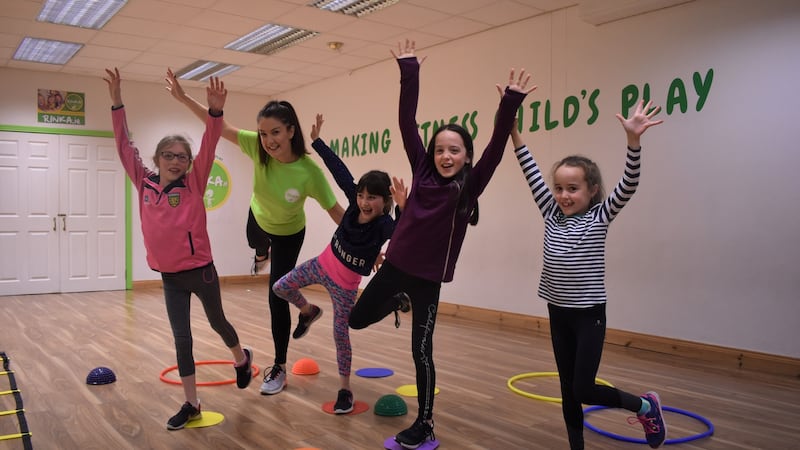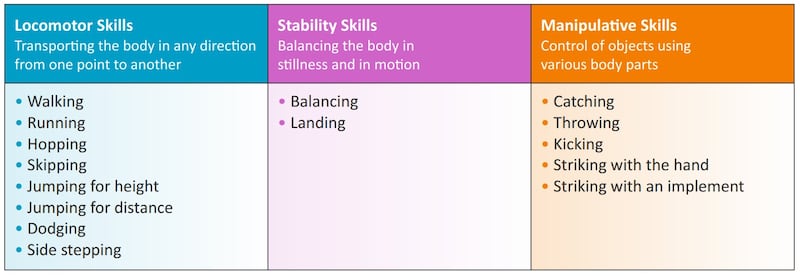The recent headline findings that “one in four primary schoolchildren can’t run properly” and “one in two can’t kick a ball properly” is further damning evidence of the impact of contemporary cooped-up childhood.
Despite years of public health “be active” campaigns and the development of various school-based activity programmes, the researchers in Dublin City University (DCU) found a worrying lack of fundamental movement skills (FMS) in the study of more than 2,000 children aged five to 12.
Sarah Gillespie, the founder of Rinka children’s fitness classes, was not at all surprised at the findings. “It is exactly what we are seeing day in, day out. It is absolutely as bad as people are saying, it’s heartbreaking.”
The day we speak, she has just finished leading a class for 10-12 year olds.
“We do very simple animal walks but the majority of those kids could not hold themselves up. They don’t have the body strength for their own body weight; we have kids who can’t get through the warm-up because it’s too taxing for them cardio-vascularly; we have kids who can’t touch their toes. It’s genuinely frightening.”
First, [children] have to be able to run, then they have to be able to catch in the air and then they have to be able to land
There needs to be a far bigger emphasis, she says, on children grasping FMS at a far younger age and continuing to develop them – “but in a fun way, it doesn’t have to be competitive”.
The term FMS might sound a tad technical but they are movements that children develop naturally, for the most part, through free play – if they’re given the chance. While FMS (see panel) are a baseline for participation in any sport, they are, more importantly, skills for life.
As lead researcher on the study Stephen Behan of DCU's school of health and human performance explains: "If children get a broad base of these skills at a young age, they will then have a tool kit so they can be active in whatever form they want to be – for life and not just for the game they are playing at the moment."
It’s a point echoed by Brian Boyle, the principal of Templederry National School in Co Tipperary, who has a particular interest in the development of FMS. “Although these children may never play sport, these skills are as simple as a farmer getting down out of a tractor or having to get over a fence.”
In addition to the lack of mastery of FMS, which children are generally expected to achieve by about the age of eight, the research also flags a worrying trend at age 10. Significant year-upon-year improvements in the children’s competency are recorded up to that age and then the progress stalls.
So, what’s happening there? Behan points out that around age 10-12 is when children become more self-conscious and peers start to become more of an influence than parents. If youngsters are not good at these basic movement skills, they feel less competent doing physical activities with friends, so are less motivated to do them, which means they don’t practise them, they don’t get any better and will increasingly want to avoid them.
It’s what the academics call “a negative spiral of disengagement”. That’s the bad news.
School-based intervention
But for all the hand-wringing that goes on for 24 hours after the publication of findings such as these, the good news is that, with the right approach, it would not take much to turn that around into a “positive spiral of engagement”. And looking at the issue of children’s inactivity through the lens of FMS provides a new focus.
Part of the “Moving Well Being Well” project, on which DCU’s Insight SFI Research Centre for Data Analytics and Dublin GAA is collaborating, has been to develop and pilot a school-based intervention to do just that. Although these findings have yet to be published, Behan indicates this can have an impact within as little as six to eight weeks.

A good grounding in FMS gives children the confidence to participate in physical activities and feeds into their enjoyment, which keeps them coming back for more; their skills improve and that motivates them further.
“None of this is rocket science,” says Gillespie. “Nothing massive needs to change; it only has to be small, regular changes every day.” And she is forthright about where she sees these adjustments need to happen.
“It’s too easy to say the Government has to do this and do that. No, this absolutely has to start at home as that is where children are 70 per cent of the time. People are sitting back looking for someone to blame and looking for someone else to come up with an answer – and the answer is right there. It makes me cross to think about it.”
Make it normal, she says, that children put their wellies on and go outside whether it’s raining or not; that they don’t get in a car for every journey; that parents take them out to kick and throw a ball – “going back to basics”.
She acknowledges that many families have two parents working outside the home but “think about the time they do spend on the phone or sitting in front of TV, it would not be hard for parents to fit in one hour”. Or even just 30 minutes on the days their children should have hopefully got at least 30 minutes of play in the school yard.
At least one hour of moderate to vigorous activity a day is recommended for children. Yet a 2018 study found that just 17 per cent of Irish primary school children achieve that.
Those 60 minutes don’t have to be clocked up all in one go – 20 minutes at school, 20 minutes after school and 20 minutes in the evening will do it, points out Behan. “Anything that gets their heart rate up – it doesn’t have to be sprinting or anything like that.”
Play with your kids
Personally, he thinks there should be more than just the one hour a week allocated to PE in primary schools “but that’s not the teachers’ fault”. However, he hopes their study will raise awareness among teachers about what they’re seeing in children – and indeed among parents too.
“If nothing else happens else from this research but that some parents start thinking ‘maybe I do have to make a bit more time to be active with the kids’ and in a broad range of basic stuff – they will be doing their kids an absolutely huge service, equipping them to be active.”

While he’s all for children being involved in as many sports and activities as they can, they don’t have to be paid, professional ones. “Parents going out and playing with their kids, or kids playing with other kids, would be massively beneficial. That free play is invaluable while they are developing.”
Bringing children to playgrounds is easy to do, he points out, “and it doesn’t have to be for a huge amount of time – little and often, instilling those good habits early on. They’ll enjoy it; you’ll rarely see anybody – bar a fall – not smiling at a playground.” (Except when it’s time to go home of course.)
Sport-specific organisations, who are keen to pull in very young children, are now better at running broad movement programmes. In the GAA’s nursery programme, for instance, he says, “the kids will think they’re playing hurling and football or camogie but they’re not, they are actually working on their fundamentals.
“As far as I can see all the major sports have gone that way – they have seen the light and the benefit.”
If children get these fundamental skills right early, they are then able to acquire more complex skills. For example, says Behan, take a player running to catch a high ball in the middle of Croke Park.
“First, they have to be able to run, then they have to be able to catch in the air and then they have to be able to land – and all the time somebody is trying to take the ball off them or hit them. When you ask a child of seven or eight to do that, who can’t run properly, or catch a ball when they are standing still, how do you expect them to be able to link these skills together?”
Boyle, who wasn’t surprised either by the study findings, observes that children are dropping out of sport – both individual and team – at a younger and younger age.
“A lot of it is down to hectic lifestyles,” he says, but also the nature of sports clubs’ ambitions. Is there pressure on children to “succeed” as opposed to develop? He is glad to see more clubs choosing the latter approach and if they realign their “success” to keeping children involved, they will probably be more successful in the long term, “even if there is no cup at the end of it. We have the responsibility to these children to [allow them] experience sport at a level that doesn’t require them to hit high standards.”
Emotional development
Boyle, who is doing a masters in Cork Institute of Technology to investigate if, as widely held, it is too late in adolescence for a youngster to improve FMS, adds that “apart from the physical benefits, there is an emotional development and resilience built through the experience of sport and movement. The challenge is to make sure play, which is a skill almost innate to young children, is not suffocated through lack of chances to experience it.”

He agrees that is probably easier for pupils of rural schools to be active than for their peers in congested, urban areas. His school has astro turf and a lot of space. “But the flip side of that is we have to walk down the village to get a hall for PE – and that brings its own challenges,” he says. “PE is probably the only subject in the whole of the primary school curriculum where some of it is very much dependent on what you don’t have, as opposed to what you have.”
However, even the smallest little things, like hopscotch games, he adds, “have a huge effect on the children being able to gallop, skip and jump”.
The Irish Heart Foundation (IHF), which has a long track record in developing physical activity resources for primary schools, is updating both its Action for Life and Bizzy Breaks programmes this year. The former supports teachers running PE classes while the latter encourages activities that take about 10 minutes to do and require minimal space – ideal for breaking up periods of sitting.
The IHF's head of health promotion, information and training, Janis Morrisey, advocates a whole-school approach to physical activity, which involves parents as well as staff and pupils. She cites the Active School Flag scheme – a Department of Education and Skills initiative supported by Healthy Ireland – as an excellent example of this.
“Often times, physical activity is at the bottom of the priority list, far below academic outcomes, despite strong evidence for the physical, mental and social benefits of physical activity for children,” she says.
Ian Dumbleton of the sport and exercise company Southside Playball in Dublin was so surprised at the findings of the DCU study, he asked his staff to check the FMS abilities of children in their classes. Playball is an international franchise that "prides itself", he says, on teaching children fundamental movement skills.
Scientific measures
They found that 90-95 per cent of their students were competent in FMS. However, that was informal testing and not the validated scientific measures that the DCU researchers use.
Behan explains that theirs are skill component tests that measure quality of movement. For example, in running, “if their right arm is moving in opposition to their left leg, that’s good”.
Most of the south Dublin schools where Dumbleton runs after-school Playball classes now also use his trainers for at least some of their in-school PE. He observes a general fall-off in FMS ability as the children get older and attributes that partly to increased screen time, as that becomes more popular around the age of nine and 10, but also to limited options for children not interested in team sports.
“We just need to get them out playing,” he adds, “whether it’s dodge ball or rip tag – without the A team and the B team and the winners and the losers.”

Rinka, which Gillespie founded in Donegal in 2015, is a similar idea to Playball. It now works with 3,000 children and 60 schools in more than 12 counties across the country, focusing on making health and fitness fun for children.
Her own experience as a champion Irish dancer and personal trainer, before being involved in a very serious car accident in Germany in 2010, makes her particularly passionate about improving the movement skills of children.
“I went through about five or six years of surgery and recovery,” says Gillespie, whose injuries included the loss of power in her right arm. However, she made a great recovery that was entirely due, according to medical staff, to how fit and healthy she was before the accident.
That struck a chord with her, having worked as a personal trainer with people who said if only they had been interested in sport as a child, or if only they had continued to play football. She wanted to help children build foundations for a healthy, active life.
“I made my recovery because I loved dancing but what about the kids who don’t, or who are not into sports? What chance do they have of being fit and healthy and developing those skills? That is where the idea came from.
“Kids just want to play and Rinka gives them space to do that,” she continues, noting that the majority of children attending have never played with a skipping rope or a hula hoop – very simple toys that foster FMS. The more work we can do in schools the better because you’re reaching every child; in the after-school classes it is the kids coming from houses who can afford to send them.”
For children it is so natural for them to move, “just encourage that and allow it – get down on your hands and knees and play”. Apart from not being given the chance to master FMS, other benefits children are deprived of through lack of exercise include endorphins, the feel-good hormones, she says. They are also “missing out on cardio-vascular, their joints, their muscles – their health.”










